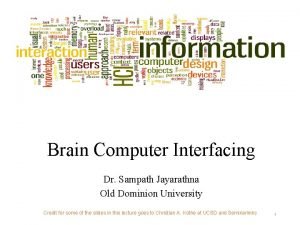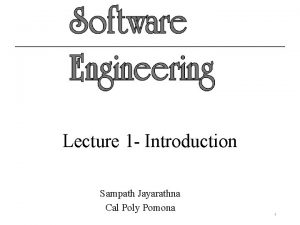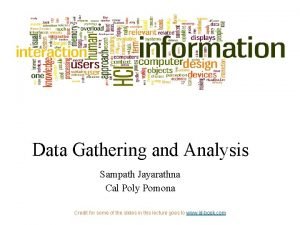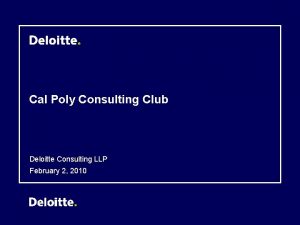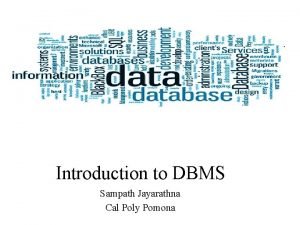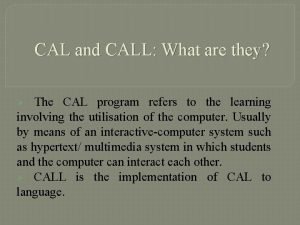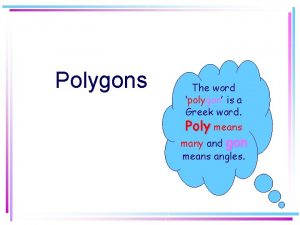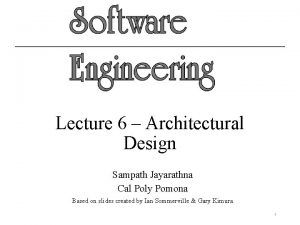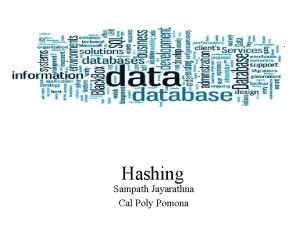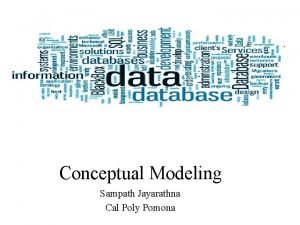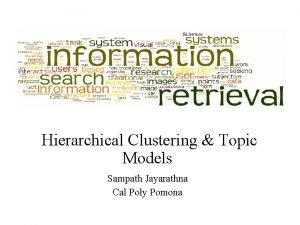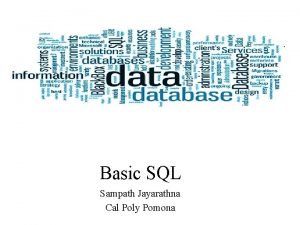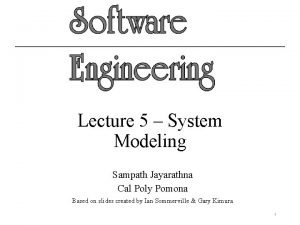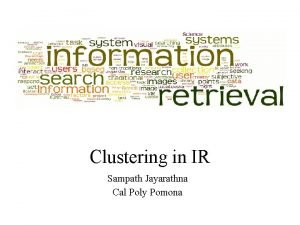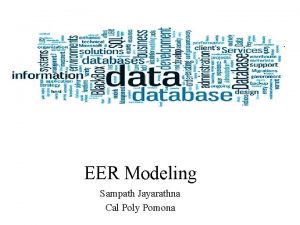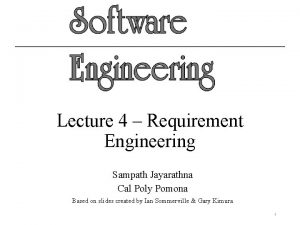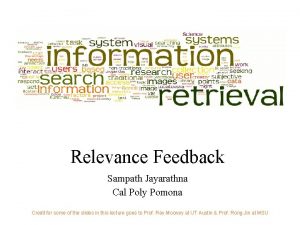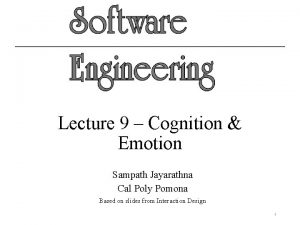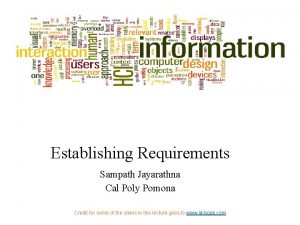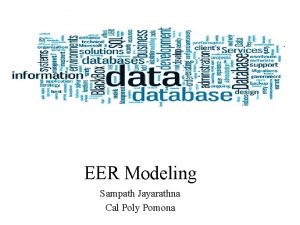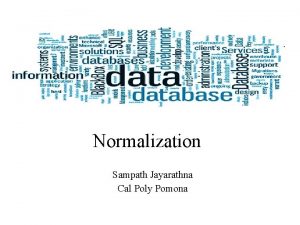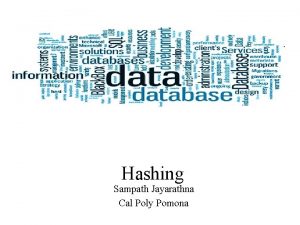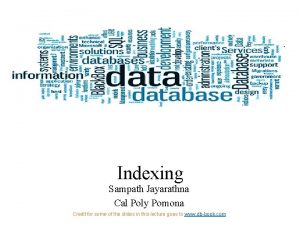Cognitive Aspects of Design Sampath Jayarathna Cal Poly



































- Slides: 35

Cognitive Aspects of Design Sampath Jayarathna Cal Poly Pomona Credit for some of the slides in this lecture goes to www. id-book. com

Why do we need to understand users? • Interacting with technology is cognitive • Need to take into account cognitive processes involved and cognitive limitations of users • Provides knowledge about what users can and cannot be expected to do • Identifies and explains the nature and causes of problems users encounter • Supply theories, modelling tools, guidance and methods that can lead to the design of better interactive products

Cognitive processes • Attention • Perception • Memory • Learning • Reading, speaking and listening • Problem-solving, planning, reasoning and decision-making

Attention • Selecting things to concentrate on at a point in time from the mass of stimuli around us • Allows us to focus on information that is relevant to what we are doing • Involves audio and/or visual senses • Focussed and divided attention enables us to be selective in terms of the mass of competing stimuli but limits our ability to keep track of all events • Information at the interface should be structured to capture users’ attention, • e. g. use perceptual boundaries (windows), colour, video, sound and flashing lights

Activity: Find the price of a double room at the Holiday Inn in Columbia

Activity: Find the price for a double room at the Quality Inn in Pennsylvania

Activity • Tullis (1987) found that the two screens produced quite different results • 1 st screen - took an average of 5. 5 seconds to search • 2 nd screen - took 3. 2 seconds to search • Why, since both displays have the same density of information (31%)? • Spacing • In the 1 st screen the information is bunched up together, making it hard to search • In the 2 nd screen the characters are grouped into vertical categories of information making it easier

Design implications for attention • Make information salient when it needs attending to • Use techniques that make things stand out like color, ordering, spacing, underlining, sequencing and animation • Avoid cluttering the interface with too much information • Search engines and form fill-ins that have simple and clean interfaces are easier to use

Perception • How information is acquired from the world and transformed into experiences • Obvious implication is to design representations that are readily perceivable, e. g. • Text should be legible • Icons should be easy to distinguish and read

Is color contrast good? Find Italian

Are borders and white space better? Find french

Activity • Weller (2004) found people took less time to locate items for information that was grouped • using a border (2 nd screen) compared with using color contrast (1 st screen) • Do you agree?

Which is easiest to read and why? What is the time? What is the time?

Design implications • Icons should enable users to readily distinguish their meaning • Bordering and spacing are effective visual ways of grouping information • Sounds should be audible and distinguishable • Speech output should enable users to distinguish between the set of spoken words • Text should be legible and distinguishable from the background • Tactile feedback should allow users to recognize and distinguish different meanings

Memory • Involves first encoding and then retrieving knowledge. • We don’t remember everything - involves filtering and processing what is attended to • We recognize things much better than being able to recall things • we remember less about objects we have photographed than when we observe them with the naked eye (Henkel, 2014)

Context is important • Context affects the extent to which information can be subsequently retrieved • Sometimes it can be difficult for people to recall information that was encoded in a different context: • “You are on a train and someone comes up to you and says hello. You don’t recognize him for a few moments but then realize it is one of your neighbours. You are only used to seeing your neighbour in the hallway of your apartment block and seeing him out of context makes him difficult to recognize initially”

Recognition versus recall • Command-based interfaces require users to recall from memory a name from a possible set of 100 s • GUIs provide MP 3 players visually-based options that users need only browse through until they recognize one • Web browsers, etc. , provide lists of visited URLs, song titles etc. , that support recognition memory

The problem with the classic ‘ 7 2’ • George Miller’s (1956) theory of how much information people can remember • People’s immediate memory capacity is very limited • Many designers think this is useful finding for interaction design • Exercise Cat, house, paper, laugh, people, red, yes, number, shadow, broom, rain, plant, lamp, chocolate, radio, one, coin, jet

What some designers get up to… • Present only 7 options on a menu • Display only 7 icons on a tool bar • Have no more than 7 bullets in a list • Place only 7 items on a pull down menu • Place only 7 tabs on the top of a website page • But this is wrong? Why?

Why? • Inappropriate application of theory • People can scan lists of bullets, tabs, menu items for the one they want • They don’t have to recall them from memory having only briefly heard or seen them • Sometimes a small number of items is good • But depends on task and available screen estate

Digital content management • Is a growing problem for many users • vast numbers of documents, images, music files, video clips, emails, attachments, bookmarks, etc. , • where and how to save them all, then remembering what they were called and where to find them again • Memory involves 2 processes • recall-directed and recognition-based scanning • File management systems should be designed to optimize both kinds of memory processes • e. g. Search box and history list • Help users encode files in richer ways • Provide them with ways of saving files using colour, flagging, image, flexible text, time stamping, etc.

Memory aids • Sense. Cam developed by Microsoft Research Labs (now Autographer) • a wearable device that intermittently takes photos without any user intervention while worn • digital images taken are stored and revisited using special software • Has been found to improve people’s memory, suffering from Alzheimers

Design implications • Don’t overload users’ memories with complicated procedures for carrying out tasks • Design interfaces that promote recognition rather than recall • Provide users with various ways of encoding information to help them remember • e. g. categories, color, flagging, time stamping

Reading, speaking, and listening • The ease with which people can read, listen, or speak differs • Many prefer listening to reading • Reading can be quicker than speaking or listening • Listening requires less cognitive effort than reading or speaking • Dyslexics have difficulties understanding and recognizing written words

Applications • Speech-recognition systems allow users to interact with them by asking questions • e. g. Google Voice, Siri, Alexa • Speech-output systems use artificially generated speech • e. g. written-text-to-speech systems for the blind • Natural-language systems enable users to type in questions and give text-based responses • e. g. Ask search engine

Learning • How to learn to use a computer-based application • Using a computer-based application or You. Tube video to understand a given topic • People find it hard to learn by following instructions in a manual • prefer to learn by doing

Design implications • Speech-based menus and instructions should be short • Accentuate the intonation of artificially generated speech voices • they are harder to understand than human voices • Provide opportunities for making text large on a screen

Cognitive prosthetic devices • We rely more and more on the internet and smartphones to look things up • Expecting to have internet access reduces the need and extent to which we remember • Also enhances our memory for knowing where to find it online (Sparrow et al, 2011) • What are implications for designing technologies to support how people will learn, and what they learn?

Dilemma • The app mentality developing in the psyche of the younger generation is making it worse for them to make their own decisions because they are becoming risk averse (Gardner and Davis, 2013) • Relying on a multitude of apps means that they are becoming increasingly more anxious about making decisions by themselves • Do you agree? Can you think of an example?

Mental models • Users develop an understanding of a system through learning about and using it • Knowledge is sometimes described as a mental model: • How to use the system (what to do next) • What to do with unfamiliar systems or unexpected situations (how the system works) • People make inferences using mental models of how to carry out tasks

Everyday reasoning and mental models You arrive home on a cold winter’s night to a cold house. How do you get the house to warm up as quickly as possible? Set thermostat to be at its highest or to the desired temperature?

Heating up a room or oven that is thermostat-controlled • Many people have erroneous mental models (Kempton, 1996) • Why? • General valve theory, where ‘more is more’ principle is generalised to different settings (e. g. gas pedal, gas cooker, tap, radio volume) • 12 • Thermostats based on model of on-off switch model

Heating up a room or oven that is thermostat-controlled • Same is often true for understanding how interactive devices and computers work: • poor, often incomplete, easily confusable, based on inappropriate analogies and superstition (Norman, 1983) • e. g. elevators and pedestrian crossings - lot of people hit the button at least twice • Why? Think it will make the lights change faster or ensure the elevator arrives!

Gulfs of execution and evaluation • The ‘gulfs’ explicate the gaps that exist between the user and the interface • The gulf of execution • the distance from the user to the physical system • The gulf of evaluation • the distance from the physical system to the user

Bridging the gulfs • Bridging the gulfs can reduce cognitive effort required to perform tasks
 Jayarathna hardware
Jayarathna hardware Beth chance
Beth chance Cal poly bike lockers
Cal poly bike lockers Cal poly pomona software engineering
Cal poly pomona software engineering Cal poly slo portal
Cal poly slo portal Cal poly pomona registrar office
Cal poly pomona registrar office Cal poly dashboard
Cal poly dashboard Cal poly slo construction management
Cal poly slo construction management Cal poly pomona dietetic internship
Cal poly pomona dietetic internship Cal poly quarter or semester
Cal poly quarter or semester Chantal bike rack
Chantal bike rack Frank owen cal poly
Frank owen cal poly Quantitative analysis cal poly
Quantitative analysis cal poly Deloitte evd
Deloitte evd Beth chance
Beth chance Cal poly databases
Cal poly databases Cal poly database
Cal poly database Cal poly academic personnel
Cal poly academic personnel Cal poly triathlon
Cal poly triathlon Cal and cal
Cal and cal Sampath kannan
Sampath kannan P sampath
P sampath Sanjay sampath
Sanjay sampath Srinidhi sampath kumar
Srinidhi sampath kumar Cognitive and non cognitive religious language
Cognitive and non cognitive religious language Abstraction-occurrence design pattern
Abstraction-occurrence design pattern The recurring aspects of designs are called design
The recurring aspects of designs are called design The recurring aspects of designs are called design
The recurring aspects of designs are called design Degree works oswego
Degree works oswego Pfp cut off
Pfp cut off Phdt
Phdt What is polymorphism in cnidaria
What is polymorphism in cnidaria What are polyhalides explain with example
What are polyhalides explain with example Polygon examples
Polygon examples Triangle quadrilateral pentagon hexagon octagon
Triangle quadrilateral pentagon hexagon octagon Polyatomic ions list
Polyatomic ions list
